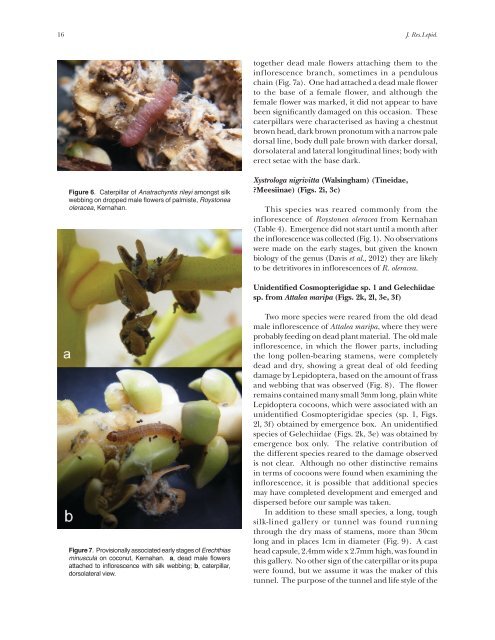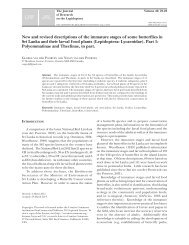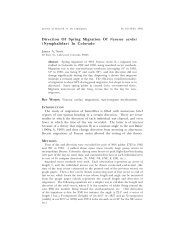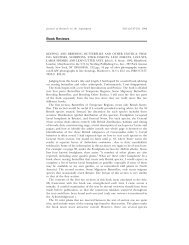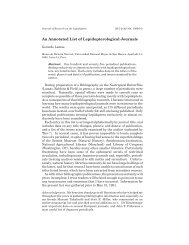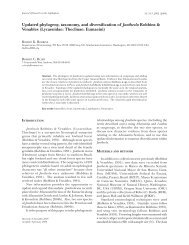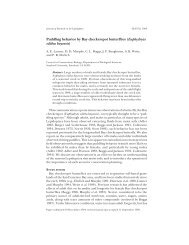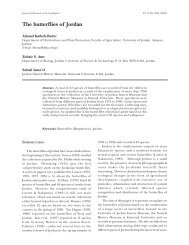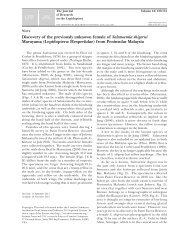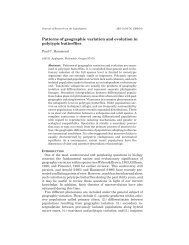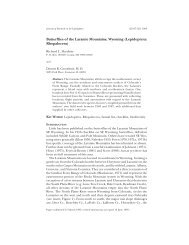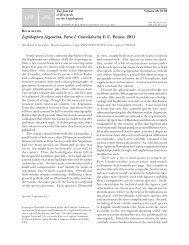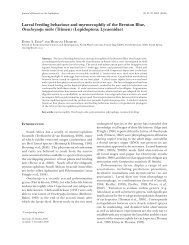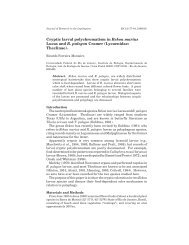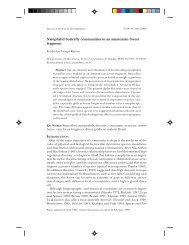Neotropical palm-inflorescence feeding moths (Lepidoptera ...
Neotropical palm-inflorescence feeding moths (Lepidoptera ...
Neotropical palm-inflorescence feeding moths (Lepidoptera ...
You also want an ePaper? Increase the reach of your titles
YUMPU automatically turns print PDFs into web optimized ePapers that Google loves.
16<br />
Figure 6. Caterpillar of Anatrachyntis rileyi amongst silk<br />
webbing on dropped male flowers of <strong>palm</strong>iste, Roystonea<br />
oleracea, Kernahan.<br />
Figure 7. Provisionally associated early stages of Erechthias<br />
minuscula on coconut, Kernahan. a, dead male flowers<br />
attached to <strong>inflorescence</strong> with silk webbing; b, caterpillar,<br />
dorsolateral view.<br />
J. Res.Lepid.<br />
together dead male flowers attaching them to the<br />
<strong>inflorescence</strong> branch, sometimes in a pendulous<br />
chain (Fig. 7a). One had attached a dead male flower<br />
to the base of a female flower, and although the<br />
female flower was marked, it did not appear to have<br />
been significantly damaged on this occasion. These<br />
caterpillars were characterised as having a chestnut<br />
brown head, dark brown pronotum with a narrow pale<br />
dorsal line, body dull pale brown with darker dorsal,<br />
dorsolateral and lateral longitudinal lines; body with<br />
erect setae with the base dark.<br />
Xystrologa nigrivitta (Walsingham) (Tineidae,<br />
?Meesiinae) (Figs. 2i, 3c)<br />
This species was reared commonly from the<br />
<strong>inflorescence</strong> of Roystonea oleracea from Kernahan<br />
(Table 4). Emergence did not start until a month after<br />
the <strong>inflorescence</strong> was collected (Fig. 1). No observations<br />
were made on the early stages, but given the known<br />
biology of the genus (Davis et al., 2012) they are likely<br />
to be detritivores in <strong>inflorescence</strong>s of R. oleracea.<br />
Unidentified Cosmopterigidae sp. 1 and Gelechiidae<br />
sp. from Attalea maripa (Figs. 2k, 2l, 3e, 3f)<br />
Two more species were reared from the old dead<br />
male <strong>inflorescence</strong> of Attalea maripa, where they were<br />
probably <strong>feeding</strong> on dead plant material. The old male<br />
<strong>inflorescence</strong>, in which the flower parts, including<br />
the long pollen-bearing stamens, were completely<br />
dead and dry, showing a great deal of old <strong>feeding</strong><br />
damage by <strong>Lepidoptera</strong>, based on the amount of frass<br />
and webbing that was observed (Fig. 8). The flower<br />
remains contained many small 3mm long, plain white<br />
<strong>Lepidoptera</strong> cocoons, which were associated with an<br />
unidentified Cosmopterigidae species (sp. 1, Figs.<br />
2l, 3f) obtained by emergence box. An unidentified<br />
species of Gelechiidae (Figs. 2k, 3e) was obtained by<br />
emergence box only. The relative contribution of<br />
the different species reared to the damage observed<br />
is not clear. Although no other distinctive remains<br />
in terms of cocoons were found when examining the<br />
<strong>inflorescence</strong>, it is possible that additional species<br />
may have completed development and emerged and<br />
dispersed before our sample was taken.<br />
In addition to these small species, a long, tough<br />
silk-lined gallery or tunnel was found running<br />
through the dry mass of stamens, more than 30cm<br />
long and in places 1cm in diameter (Fig. 9). A cast<br />
head capsule, 2.4mm wide x 2.7mm high, was found in<br />
this gallery. No other sign of the caterpillar or its pupa<br />
were found, but we assume it was the maker of this<br />
tunnel. The purpose of the tunnel and life style of the


